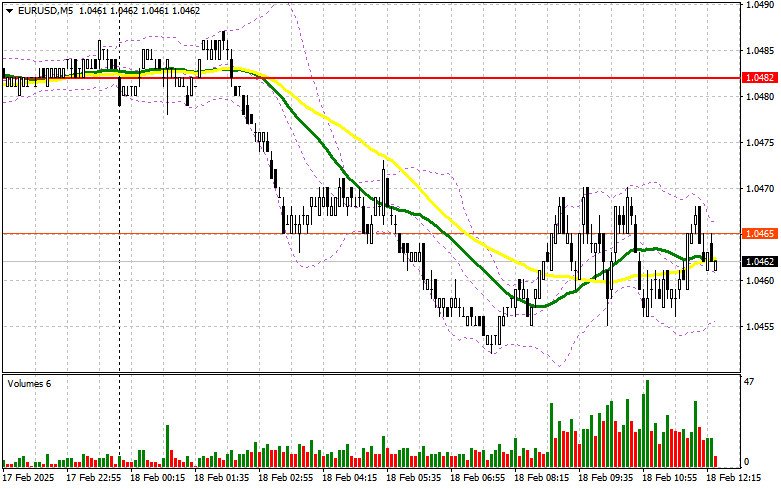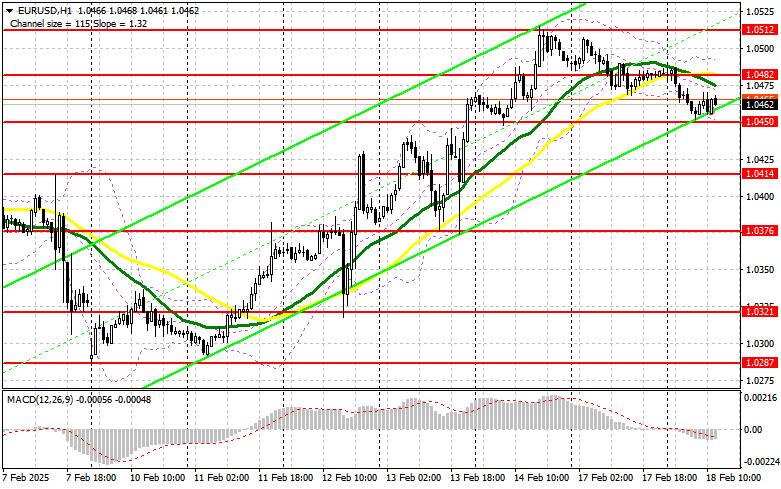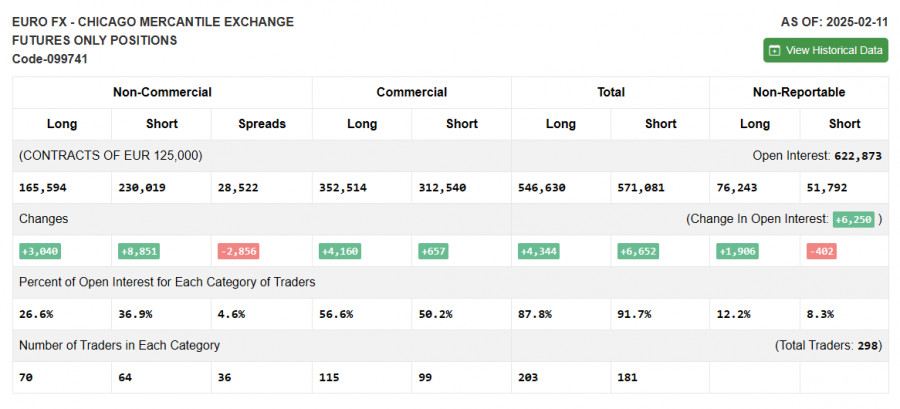In my morning forecast, I highlighted the level of 1.0450 as a key point for making market entry decisions. Looking at the 5-minute chart, the price declined towards 1.0485, but no suitable entry points formed. The technical outlook remains unchanged for the second half of the day.
To Open Long Positions on EUR/USD:
Despite the release of positive economic data from Germany and the Eurozone, the euro showed no momentum. It appears that buyers have exhausted their strength, and traders are now focusing on the meeting between US and Russian representatives regarding the Ukraine conflict resolution. Positive news from these discussions could trigger renewed demand for risk assets.
Additionally, key US economic releases in the second half of the day include the Empire Manufacturing Index and the NAHB Housing Market Index. Traders will also closely watch FOMC member Michael S. Barr's speech for potential policy hints.
If the pair declines, I will consider buying after a false breakout at 1.0450, aiming for a rebound toward resistance at 1.0482, formed from yesterday's highs. A break and retest of this level will confirm a stronger entry point for long positions, targeting 1.0512, with a final objective at 1.0554, where I plan to take profits.
If EUR/USD falls further and buyers fail to defend 1.0450, the bearish pressure will increase, pushing the pair toward 1.0414. In this scenario, I will wait for a false breakout at 1.0414 before considering new long positions. A direct buy from the 1.0376 level will be an option only for a 30-35 point intraday correction.
To Open Short Positions on EUR/USD:
Bears showed no reaction to Eurozone data, keeping their focus on the US-Russia negotiations. The priority remains defending resistance at 1.0482, as breaking this level would extend the bullish trend. To confirm a bearish presence, I will look for a false breakout at 1.0482, which would indicate the presence of large sellers betting on a decline.
The first target for short positions will be 1.0450, which also coincides with moving averages supporting the bulls. A break and retest of this level from below—coupled with strong US data and hawkish Fed comments—will provide an additional entry signal for shorts, with targets at 1.0414 and 1.0376, where I will take profits.
If EUR/USD rises in the second half of the day, and bears fail to defend 1.0482, where moving averages also provide resistance, buyers could push the pair even higher. In this case, I will delay short positions until testing the next resistance at 1.0512. Shorts will be considered only after a failed breakout attempt at this level. If no downward movement occurs from there, I will look to sell from 1.0554, targeting a 30-35 point correction.
Commitment of Traders (COT) Report:
The COT report from February 1 showed an increase in both long and short positions. However, there were more sellers than buyers, though it is important to note that the report does not account for the phone conversation between Putin and Trump. Market sentiment may have shifted in favor of buyers, but this will only be confirmed in next week's data.
For now, the weakness of the US dollar is expected to persist, especially given the moderate economic data from the US in recent weeks. The report indicated that long non-commercial positions increased by 3,040 contracts to 165,594, while short non-commercial positions rose by 8,851 contracts to 230,019. As a result, the spread between long and short positions narrowed by 2,856.
Indicator Signals
Moving Averages
The pair is trading below the 30- and 50-day moving averages, signaling further euro weakness.
Bollinger Bands
If the price declines, the lower boundary of the indicator near 1.0450 will act as support.
Indicator Descriptions:
- Moving Averages (MA): Identify current trends by smoothing volatility and market noise.
- MACD Indicator: Measures the convergence/divergence of moving averages to indicate potential trend reversals.
- Bollinger Bands: Measure volatility and identify overbought/oversold market conditions.
- Non-commercial Traders: Speculators such as hedge funds and large institutions that use futures markets for speculation.
- Net Non-commercial Position: The difference between long and short positions held by speculative traders.














